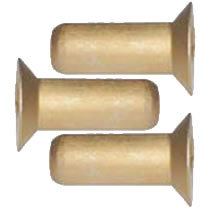
Solid rivets are one of the most common types of mechanical fasteners used in the aerospace manufacturing industry. Like all rivets, they are designed to resist external forces, such as vibrations. Solid rivets, however, feature a solid construction that distinguishes them from blind rivets. Here are the pros and cons of solid rivets that you need to know.
Pro: Strong and Durable
You can rest assured knowing that solid rivets are strong and durable. Some of them are made of titanium, whereas others are made of aluminum alloy or nickel alloy. Regardless, their solid construction makes them incredibly strong and durable.
Pro: No Re-Tightening Required
Solid rivets don’t require re-tightening. As permanent fasteners, they are designed for permanent usage. Once you install a solid rivet, you won’t have to go back and re-tighten or otherwise adjust it. The same can’t be said for traditional fasteners, such as nuts and bolts. Traditional fasteners may loosen over time, at which point you’ll have to re-tighten them.
Pro: Cost-Effective
Solid rivets are cost-effective. They feature a simple design consisting of a head and shank. Thanks to their simple design, they cost less to produce than other, more complex types of fasteners. If you’re on a budget, you can’t go wrong with solid rivets for this reason.
Con: Requires Access to Both Sides
Solid rivets require access to both sides of the parts with which you intend to use them. If you only have access to the front of the parts, you may want to use blind rivets, instead. Blind rivets differ from solid rivets in the sense that they only require access to one side of the parts.
Con: Tooling Required
You’ll also need a special tool to install solid rivets, such as a compression tool. Compression tools work by applying pressure to rivets, thereby causing them to deform. To install a solid rivet, you’ll typically need to drill a hole in the parts that you want to fasten. You can then place the solid rivet inside of the hole, followed by using a compression tool.
Con: Limited Reusability
Solid rivets offer limited reusability. Once installed, you won’t be able to easily remove them. Installation involves the deformation of a solid rivet. So, even if you’re able to remove a solid rivet after installing it, the rivet will likely be damaged, making it difficult or impossible to reuse.



